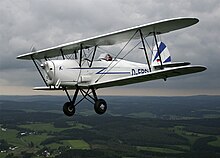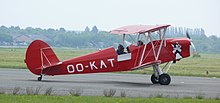Stampe & Vertongen SV-4
The Stampe & Vertongen SV-4 is an aerobatic double - decker aircraft from the 1930s.
history
In 1932 Stampe & Vertongen's designer, Georges Ivanow , was commissioned to design a new machine, the SV-4. This was clearly based on the De Havilland "Tiger Moth" , which was sold by the company in Belgium. The first flight took place on May 13, 1933.
After the crash of the twin-engine SV-10 in 1935, in which Georges Ivanow and Leon Stampe (Jean's son) died, Stampe & Vertongen stopped all further design and construction activities and concentrated on maintenance work. After repeated requests from Elza Leyzen , a former student pilot of Jean Stampe, Stampe & Vertongen reopened the production line for the SV-4. B. Demidoff was hired as a new designer.
In France, Nord Aviation manufactured the SV-4 C with a Renault engine under license.
construction
The SV-4C model is equipped with a 145 hp hanging 4-cylinder Renault P-PEI engine with which it can reach a maximum of 198 km / h. The engine is started with compressed air from a compressed air bottle that is carried along, which is refilled by a small compressor operated by the engine. If the bottle is empty after several unsuccessful starting attempts, the engine can also be started by hand.
The aircraft is suitable for aerobatics, even if some figures are not permitted or are limited in time. Models with dry sump lubrication are also suitable for backflighting. The fuselage is made of stretched ash wood strips and covered with fabric. The wings as well as the tail unit are also made of wood. Only the fittings, the braces and handles, the tank and the engine mount are made of metal.
In contrast to the Tiger Moth, the Stampe & Vertongen SV-4 has ailerons on both wings and is therefore particularly agile around the longitudinal axis. The aircraft is two-seated and has dual controls. In single-seat flight, it is controlled from the rear seat for reasons of center of gravity. The SV-4 has a rigid tail wheel chassis. The wheels have mechanical brakes.
use
The Belgian Air Force wanted to replace its DH82 “Tiger Moth” after the Second World War and in 1947 ordered 65 SV-4B for the “Ecole de Pilotage Elementaire” (Basic Flying Training). The future pilots began their flight training on SV-4B until they were replaced by SIAI-Marchetti SF.260 in 1969 .
A total of around 1000 of the Stampe & Vertongen SV-4s were built for basic training in the French and Belgian air forces. The last SV-4B was not completed until October 7, 1955. Today there are still around 15 aircraft of this type in Germany.
Technical data (SV-4 C)
| Parameter | Data |
|---|---|
| span | 8.40 m |
| length | 6.90 m |
| height | 2.60 m |
| Wing area | 18.00 m² |
| Empty mass | 505 kg |
| maximum take-off mass | 780-825 kg |
| Engine | an air-cooled four-cylinder in-line engine type de Havilland Gipsy Major 10 with 107 kW starting power or Renault PO3 or PO5 with two oil pumps each 107 kW from a displacement of 7.6 l. |
| Top speed | 275 km / h |
| Cruising speed | 150 km / h |
| Service ceiling | 5000 m |
| Range | 450 km with 80 km reserve |
Trivia
In the movie Indiana Jones and the Last Crusade , Indiana Jones and his father escape from their pursuers in the zeppelin with an SV-4, which is supposed to represent a German airplane in the film.
See also
Web links
- Interest group for the preservation of historic aircraft with seven SV-4
- Quax support association for historical aircraft with its own SV-4C
- Pictures of Stampe SV-4 from Germany and Belgium
- Company history
Individual evidence
- ↑ German biplane. Retrieved February 26, 2020 .





